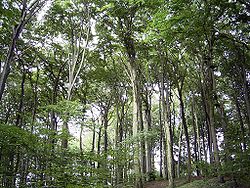Stratification (vegetation)

Stratification in the field of
Vertical structure in terrestrial plant habitats

The following layers are generally distinguished:

Besides the superposition of different plants growing on the same soil, there is a lateral impact of the higher layers on adjacent plant communities, for example, at the edges of forests and bushes. This particular vegetation structure results in the growth of certain vegetation types such as forest mantle and margin communities. [citation needed]
Tree layer
This layer of vegetation starts from a height of about 5 metres and comprises the top stratum, which consists of
Canopy
The canopy usually refers to the highest layer of vegetation in a forest or woodland, made up of the crowns of its tallest trees. However, individual trees growing above the general layer of the canopy may form an
Understory
The understory can refer to those trees above the shrub layer and below the canopy, but is often defined more broadly, including the shrub layer. [citation needed]
Shrub layer
The shrub layer is the stratum of vegetation within a habitat with heights of about 1.5 to 5 metres. This layer consists mostly of young trees and bushes, and it may be divided into the first and second shrub layers (low and high bushes). The shrub layer needs sun and little moisture, unlike the moss layer which requires a lot of water. The shrub layer only receives light filtered by the canopy, i.e. it is preferred by semi-shade or shade-loving plants that would not tolerate bright sunlight. Small to medium sized birds sometimes known as bush nesters are often found in the shrub layer where their nests are protected by foliage. European examples include blackbird, song thrush, robin or blackcap. In addition to shrubs, such as elder, hazel, hawthorn, raspberry and blackberry, clematis may also occur while, in other parts of the world, vines and lianas may form part of this stratum. At the edge of a woodland the shrub layer acts as a windbreak close to the trees and protects the soil from drying out. [citation needed]
Herb layer

This layer contains mostly non-woody vegetation, or
Forest floor
The term forest floor can refer to the moss and root layers (see below), but often is defined more broadly, including also dead trees, herbaceous plants, mushrooms, and tree seedlings. [citation needed]
Moss layer
Growing on the surface of the forest floor is vegetation of up to about 0.15 metres in height in what is variously described as a moss, soil or
Root layer
Also known as the rhizosphere, the underground area of a plant habitat is the root layer. It consists of the plants' roots and related elements such as rhizomes, bulbs and tubers. [citation needed]
See also
References
- ^ Whittow, Dictionary of Physical Geography.
- ^ "Nine Layers of the Edible Forest Garden (Food Forest) | Temperate Climate Permaculture".
- PMID 33384906.
Bibliography
- Dierschke, Hartmut (1994). Pflanzensoziologie Grundlagen und Methoden ; 55 Tabellen (in German). Stuttgart. )
- C. S. Elton: Animal Ecology. Sidgwick & Jackson, London, 1927.
- M. Schaefer: Wörterbuch of the Ökologie. Spektrum, Jena, 1992. ISBN 3-8252-0430-8
